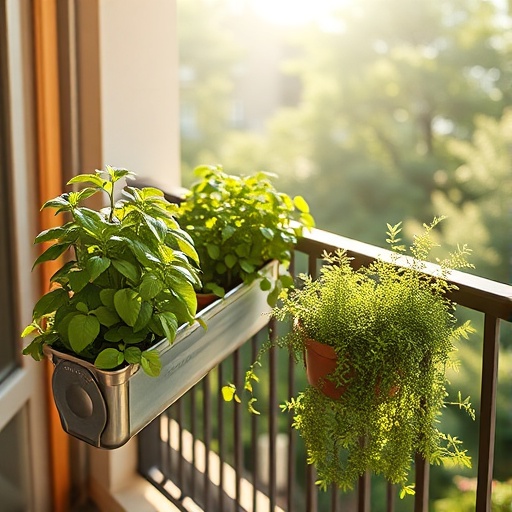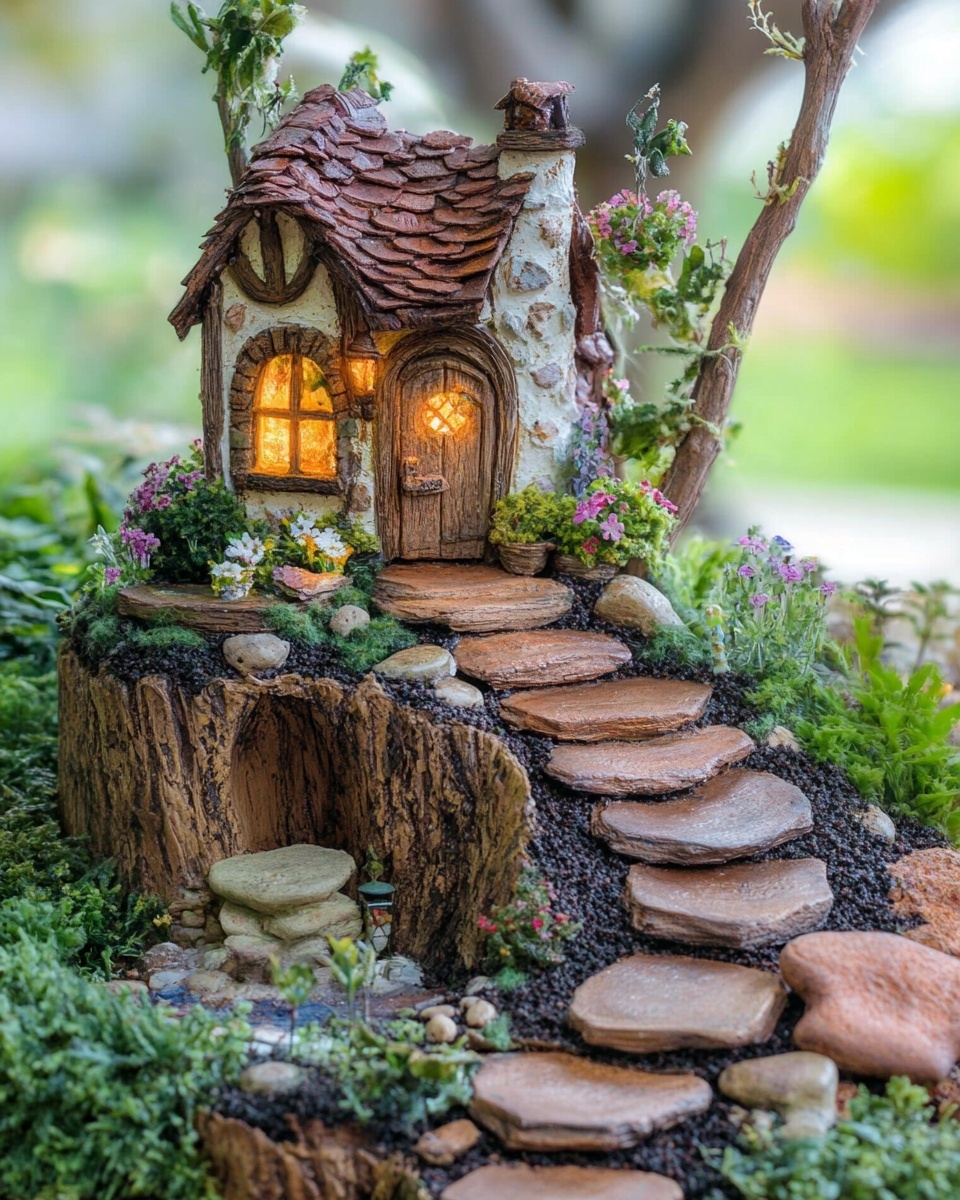Introduction
Ever gazed at a sun-drenched balcony and wondered if it could be more than just a place to store forgotten items? Perhaps a vibrant, aromatic haven where fresh ingredients are always within arm’s reach? Many budding gardeners believe that cultivating their own produce requires expansive yards or complex setups. But what if I told you that transforming even the smallest sunny spot into a thriving kitchen herb garden is not only achievable but immensely rewarding? This article is your definitive guide to creating the ultimate kitchen herb garden ideas for your sunny balcony, proving that delicious, home-grown flavor is just a few pots away, regardless of your space limitations.
Tools & Materials Needed
Embarking on your herb-growing journey doesn’t require an arsenal of expensive equipment. In fact, many of the essentials might already be lurking in your home! To set up your perfect outdoor herb sanctuary, here’s what you’ll need:
- Pots/Containers: Choose pots with drainage holes to prevent root rot. Terracotta pots look classic, but plastic, ceramic, or fabric grow bags (which are excellent for aeration and budget-friendly) also work wonders. Aim for containers that are at least 6-8 inches in diameter for individual herbs, or larger rectangular planters for companion planting.
- Quality Potting Mix: This is crucial. Don’t skimp here! A good organic potting mix designed for containers provides the right balance of nutrients, drainage, and aeration. Look for blends that include perlite or vermiculite. Avoid using dense garden soil, as it compacts easily in pots.
- Herb Seeds or Starter Plants: For beginners, starter plants offer a head start and higher success rates. For the adventurous, seeds are more economical and offer a wider variety. Consider eco-friendly heirloom seeds for sustainability.
- Small Trowel: Essential for digging and transplanting.
- Watering Can with a Fine Rose: Gentle watering prevents soil erosion and damage to delicate seedlings. A simple repurposed gallon jug with holes poked in the lid works too!
- Gardening Gloves: Protect your hands from soil and potential irritants.
- Pruning Shears/Scissors: For harvesting and shaping your herbs. Clean, sharp cuts promote healthier regrowth.
- Optional but Recommended:
- Plant Labels: Keep track of what you’ve planted and where. Craft sticks or repurposed plastic items work perfectly.
- Drip Trays/Saucers: To catch excess water and protect your balcony surface.
- Organic Liquid Fertilizer: For a nutrient boost during the growing season. Compost tea is a fantastic eco-friendly alternative.
Time & Effort Overview
Setting up your kitchen herb garden ideas on a sunny balcony is surprisingly quick, often taking less than an afternoon. The initial planting phase can be completed within 1-2 hours for a modest collection of 5-7 different herbs. Compared to growing vegetables from seed, which can take weeks to sprout and months to harvest, many herbs offer a much faster turnaround. For instance, basil can be ready for its first harvest in as little as 3-4 weeks from a young plant, growing approximately 25% faster than typical fruiting plants like tomatoes.
The real “effort” comes in the consistent, mindful daily or weekly care. This project is firmly in the beginner-friendly category. If you’ve never grown anything before, herbs are an ideal starting point. Their resilience and relatively quick growth cycles provide instant gratification and a fantastic learning curve. Dedicate 5-10 minutes each day for a quick check-in and watering, and perhaps 30 minutes once a week for more in-depth maintenance like pruning and fertilizing.
Preparing Your Soil and Pots
The foundation of any successful garden is healthy soil. For your kitchen herb garden ideas to flourish, start by cleaning your chosen pots, especially if they’re repurposed. Mix your organic potting mix with a little compost if you have it – this enhances nutrient content and microbial activity. Fill each pot to about an inch from the rim. This leaves space for watering without overflow.
Planting Your Herbs
Whether you’re starting from seeds or seedlings, handle them gently.
- For Seeds: Create small depressions in the soil with your finger, following package instructions for depth and spacing. Cover lightly with soil and water gently. Don’t worry if all seeds don’t sprout; that’s natural.
- For Seedlings/Starter Plants: Carefully remove the plant from its nursery pot, loosening any circling roots at the bottom. Dig a hole large enough to accommodate the root ball, ensuring the plant is at the same soil level as it was in its original container. Backfill with soil, gently firming it around the base.
Initial Watering and Placement
Immediately after planting, water your herbs thoroughly. The goal is to moisten the entire root ball and potting mix. Place your freshly planted herbs in their sunny balcony spot. Most herbs thrive with at least 6 hours of direct sunlight daily, so choose your sunniest location.
Establishing a Watering Routine
Consistency is key, but so is observation. Stick your finger about an inch into the soil. If it feels dry, it’s time to water. If it’s still moist, hold off. Overwatering is a common killer of container herbs, leading to root rot. Here’s how to fix that: if leaves are yellowing and wilting despite moist soil, it’s likely overwatering. Let the soil dry out completely before watering again.
Pruning for Bushier Growth
Once your herbs start to grow vigorously, usually after a few weeks, begin to prune them. This isn’t just for harvesting; it encourages the plant to branch out, creating a bushier, more productive plant. Use clean shears or scissors to snip off the top few sets of leaves, just above a leaf node.
Growth & Care Tips
Consistent care is the secret ingredient for a thriving kitchen herb garden ideas sanctuary. Here’s how to keep your green friends happy and healthy:
- Watering Frequency: As a general rule, container herbs typically need watering every 1-3 days, especially during hot summer months. However, this varies significantly based on herb type, pot size, and weather. Drought-tolerant herbs like rosemary and thyme prefer drier conditions, while basil and mint need more consistent moisture. Overwatering is a leading cause of herb plant failure, accounting for over 60% of common gardening issues, often leading to fungal diseases and root rot. Always check the soil moisture before watering.
- Sunlight Exposure: Most herbs demand abundant sunshine. Aim for a minimum of 6 hours of direct sunlight per day. South-facing balconies are ideal. If your balcony gets less sun, choose herbs that tolerate partial shade, like mint, parsley, and cilantro.
- Pruning for Productivity: Regular pruning is essential not just for harvesting but for plant health. By snipping off the top few leaves or flower buds, you signal the plant to divert energy into producing more foliage rather than going to seed (bolting). This keeps herbs like basil, mint, and cilantro bushy and extends their usability. For woody herbs like rosemary and thyme, gentle shaping helps maintain their form and encourages fresh growth. Data suggests regular pruning can increase herb yield by up to 30% over a growing season.
- Fertilization: While a good potting mix provides initial nutrients, container herbs will eventually deplete these. A light feeding every 3-4 weeks with a balanced organic liquid fertilizer is beneficial, especially during active growth periods. Dilute fertilizers to half strength to avoid nutrient burn. For a natural boost, consider using compost tea.
- Pest Prevention: Herbs are relatively pest-resistant, but they aren’t immune. Keep an eye out for common culprits like aphids or spider mites. A strong spray of water can dislodge many pests. For persistent issues, a neem oil spray (organic and safe for edibles) can be effective. Healthy plants are more resistant to pests, so ensure proper watering and sunlight.
Eco-Friendly & Sustainable Alternatives
Cultivating your kitchen herb garden ideas with an eye toward sustainability is easier than you think and benefits both your plants and the planet:
- Composting: Turn your kitchen scraps into gold for your herbs! A small worm bin or a simple countertop compost pail can transform fruit and vegetable peels into nutrient-rich compost that enriches your potting mix.
- Rainwater Harvesting: Collect rainwater in a clean bucket. Rainwater is naturally softer and free of chlorine, making it excellent for watering your herbs. It can significantly reduce your municipal water usage.
- DIY Fertilizers: Instead of store-bought chemical fertilizers, opt for homemade solutions. Compost tea (steeping compost in water) or diluted fish emulsion are fantastic organic options. Even coffee grounds, in moderation, can add nitrogen to the soil.
- Repurposed Containers: Before buying new pots, look around for items that can be upcycled. Old plastic bottles, tin cans (with drainage holes added), or even sturdy food-grade buckets can make excellent planters. Just ensure they are clean and safe for growing edibles.
- Vertical Gardening: For truly small spaces, consider vertical planters or wall-mounted pockets. This maximizes your growing area without taking up precious balcony floor space, turning a blank wall into a flourishing herb wall. You might find some excellent inspiration for a vertical garden here.
- Companion Planting: Strategically plant certain herbs together. For example, rosemary and sage thrive together and their strong scents can deter pests from other plants.
- Planting from Scraps: Many herbs, like basil, mint, and even green onions, can be regrown from cuttings or kitchen scraps, offering an unending supply and reducing waste.
Creative Ideas & Uses
A kitchen herb garden ideas project isn’t just about growing food; it’s an opportunity for creative expression and sensory delight.
- Aesthetic Groupings: Arrange your herb pots by height, color, or texture. Grouping various shades of green, like the dark leaves of basil next to the delicate fronds of dill, creates visual interest. Consider using tiered plant stands to add dimension to your balcony layout.
- Edible Landscaping: Instead of purely ornamental plants, integrate herbs into your existing balcony decor. Rosemary can be a fragrant, evergreen shrub, while trailing thyme can spill beautifully over pot edges. Lavender adds a stunning purple bloom and a calming aroma.
- Repurposed Planters for Charm: Get creative with your containers! An old wooden wine crate lined with plastic makes a rustic planter. Mason jars, with proper drainage, can add a farmhouse chic touch. Even old teacups can host tiny, delicate herbs like chives.
- Herbal Pathways: If your balcony has enough space, create a small “path” using flat stepping stones, with low-growing, fragrant herbs like creeping thyme planted between them. Each step releases a delightful aroma.
- DIY Herb Markers: Beyond basic labels, craft unique markers. Paint small stones, use wooden skewers with etched names, or attach decorated clothes pins to the pot rim.
- Culinary Corner: Dedicate a section of your balcony to the herbs you use most frequently near your kitchen door. This not only makes harvesting convenient but also emphasizes the “kitchen” aspect of your garden.
- Mix and Match: Don’t be afraid to combine herbs in larger pots, ensuring they have similar light and water requirements. For instance, a Mediterranean pot could feature rosemary, thyme, and oregano.
For more small space inspiration, including clever planter setups and plant choices, you might enjoy these small apartment indoor gardening hacks.
Common Mistakes to Avoid
Even seasoned gardeners make mistakes, and when you’re just starting your kitchen herb garden ideas, it’s easy to fall into common traps. Knowing what to watch out for can save you a lot of heartbreak and ensure your herbs thrive.
- Overwatering: This is by far the most insidious killer of container herbs. As mentioned, overwatering can cause root rot, drowning the roots and preventing them from taking up nutrients. Studies show that between 60-70% of beginner plant deaths are attributable to improper watering. Always check the soil before watering; if the top inch feels moist, wait.
- Insufficient Drainage: Pots without drainage holes are death traps for most herbs. Water accumulates, suffocating roots. If your favorite decorative pot lacks holes, either drill some or use it as a cachepot, placing a well-draining pot inside.
- Ignoring Sunlight Requirements: While some herbs tolerate partial shade, most robustly flavorful herbs like basil, rosemary, and oregano demand at least 6 hours of direct sunlight. Placing them in too much shade leads to leggy, weak growth and diminished flavor.
- Using Garden Soil: Garden soil is heavy and dense. In containers, it compacts easily, hindering drainage and aeration crucial for root health. Always use a high-quality, well-draining potting mix.
- Over-fertilization: More isn’t always better. Excess fertilizer can “burn” the delicate roots of herbs, especially if they are young or less established. Stick to diluted organic fertilizers and follow recommended schedules.
- Neglecting Pruning: While it might seem counterintuitive to cut off healthy growth, neglecting to prune herbs like basil and mint leads to leggy plants that prioritize flowering (and seed production) over leaf growth. Once an herb flowers, its flavor often diminishes.
- Planting Incompatible Herbs Together: While companion planting is great, ensure the herbs in one pot have similar watering and sunlight needs. For example, a water-loving mint shouldn’t share a pot with a drought-tolerant rosemary.
- Ignoring Pest and Disease Signs: A quick daily check of your plants for discolored leaves, sticky residue, or tiny insects can prevent a small issue from becoming an infestation. Early detection is key to gentle, organic treatment.
Maintenance & Storage Tips
Ensuring your kitchen herb garden ideas remain vibrant and productive year-round involves a little ongoing attention and smart storage practices for your bountiful harvests.
- Seasonal Care:
- Spring: This is prime planting time! Repot any root-bound herbs, refresh the top layer of soil with new potting mix and compost, and start your seeds or plant new seedlings.
- Summer: Water more frequently as temperatures rise. Keep up with judicious pruning to encourage growth and prevent bolting (going to seed). Protect delicate herbs from scorching afternoon sun if your balcony gets extreme heat.
- Autumn: Many annual herbs will begin to fade. Harvest any remaining leaves for storage. Perennial herbs can be brought indoors before the first frost if you wish to overwinter them, or insulated if staying outside.
- Winter: If herbs are overwintered indoors, reduce watering significantly. Provide supplemental light if natural light is scarce. For outdoor perennials, ensure pots are insulated (e.g., wrapped in burlap) to protect roots from freezing.
- Addressing Common Issues:
- Yellow Leaves: Usually a sign of overwatering or nutrient deficiency. Check soil moisture first. If it’s consistently wet, let it dry out. If dry, a light feeding might be needed. Poor soil drainage can also contribute.
- Wilting Leaves (Despite Watering): Can indicate root rot (from overwatering) or, conversely, severe underwatering. Check the soil. If it’s soggy, it’s root rot. If bone dry, it needs water immediately.
- Leggy Growth: Often due to insufficient light. Move plants to a sunnier spot and prune back leggy stems to encourage bushier growth lower down.
- Harvesting and Storage:
- Fresh: Harvest herbs in the morning after dew has dried but before the heat of the day. Snip off outer leaves or upper stems. Store fresh herbs by placing stems in a glass of water on the counter (like a bouquet) or wrapping them in a damp paper towel and refrigerating.
- Drying: For herbs like rosemary, thyme, oregano, and lavender, hang small bunches upside down in a cool, dark, well-ventilated area until brittle. Crumble and store in airtight containers. A food dehydrator also works well.
- Freezing: Basil, parsley, cilantro, and chives freeze beautifully. Chop them finely, add a touch of olive oil, and freeze in ice cube trays. Once solid, transfer to freezer bags. This is an excellent way to preserve their fresh flavor for months.
- Infused Oils/Vinegars: A delightful way to preserve and use robust herbs like rosemary, thyme, or oregano. Ensure herbs are completely dry to prevent spoilage.
Conclusion
Transforming your sunny balcony into a productive and aromatic kitchen herb garden ideas haven is an incredibly rewarding endeavor. From the simple joy of snipping fresh basil for your pasta to the vibrant scent of rosemary wafting through your outdoor space, the benefits extend far beyond just culinary convenience. We’ve covered everything from selecting the right pots and nurturing your seedlings to sustainable practices and common pitfalls to avoid. Remember, gardening is a journey of learning and discovery, and every snip and sprout brings a new sense of accomplishment. You don’t need a sprawling backyard to cultivate a thriving connection with nature and delicious, home-grown flavors. Your balcony is a canvas waiting for your green thumb!
So, what are you waiting for? Take that first step, get your hands in the soil, and start cultivating your very own fragrant oasis. Share your newfound kitchen herb garden ideas with us – we’d love to see your progress! Pop a comment below with which herbs you’re most excited to grow, or tag us in your garden photos.
FAQ
Q1: What are the easiest herbs for a beginner to grow on a balcony?
A1: For beginner kitchen herb garden ideas, basil, mint, chives, and parsley are excellent choices. They are relatively forgiving, grow quickly, and offer a great sense of accomplishment. Rosemary and thyme are also quite hardy once established.
Q2: How much sunlight do herbs need on a balcony?
A2: Most culinary herbs thrive on a sunny balcony with at least 6 hours of direct sunlight per day. South-facing balconies are ideal. If your balcony receives less sun, consider herbs like mint, parsley, or cilantro, which can tolerate some partial shade.
Q3: How do I know if I’m overwatering or underwatering my herbs?
A3: The best way to check is to stick your finger about an inch or two into the soil. If it feels dry, it’s likely time to water. If it’s still moist, hold off. Yellowing leaves and wilting can indicate both overwatering (soil is soggy) or underwatering (soil is bone dry). Proper drainage is crucial to prevent overwatering.
Q4: Can I grow different types of herbs in the same pot?
A4: Yes, but choose herbs with similar needs. For instance, Mediterranean herbs like rosemary, thyme, and oregano prefer drier conditions, while basil, mint, and cilantro need more consistent moisture. Grouping by water requirements is key for successful kitchen herb garden ideas in shared containers.
Q5: My herbs are getting tall and sparse. What should I do?
A5: This “leggy” growth often indicates insufficient light or a need for pruning. Move your plants to a sunnier spot on your balcony. Also, regularly “pinch back” or prune the top few sets of leaves, just above a leaf node. This encourages bushier growth and prevents the plant from focusing its energy on flowering.
Q6: How often should I fertilize my balcony herbs?
A6: If you’re using a good quality potting mix, light feeders like most herbs don’t need excessive fertilization. A dilute organic liquid fertilizer every 3-4 weeks during the active growing season (spring and summer) is usually sufficient. Avoid over-fertilizing, which can harm your plants. For more detailed tips specific to indoor setups, check out our guide on easy indoor gardening setups.
Q7: What are some good resources for more balcony gardening inspiration?
A7: For visual inspiration and a wealth of tips, sites like Pinterest are fantastic! Many gardeners share their creative balcony setups. You can often find great visual content on Pinterest for gardening ideas.
You may also enjoy reading:






